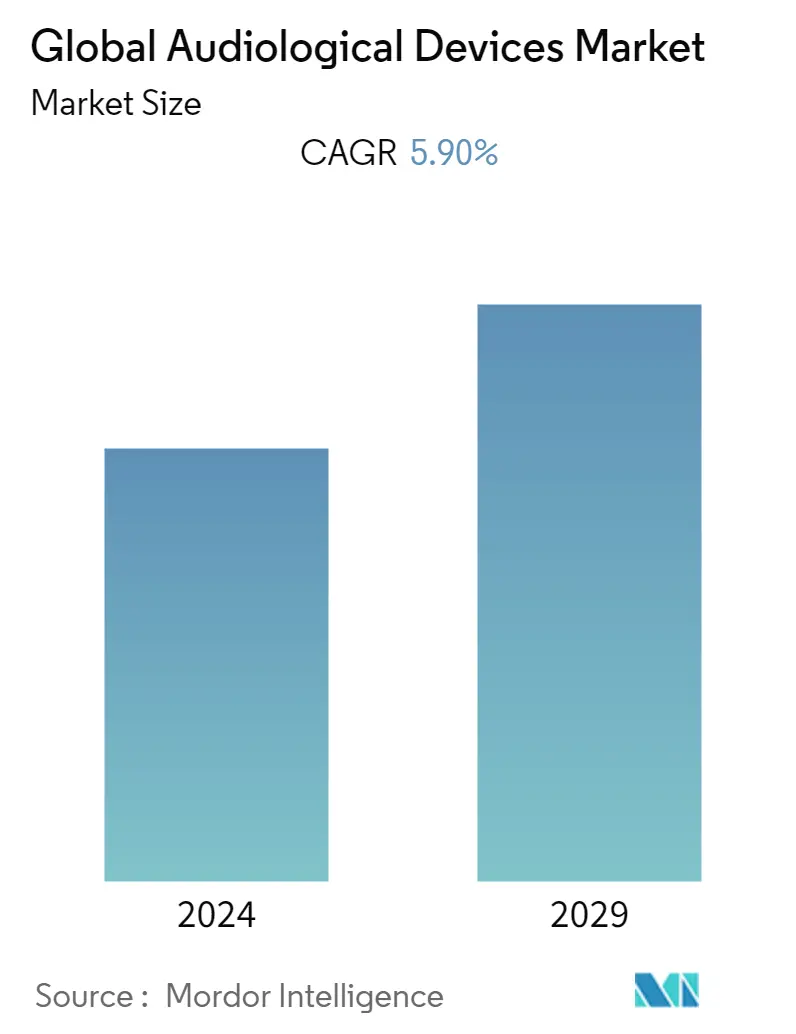Market Size of Global Audiological Devices Industry

| Study Period | 2019 - 2029 |
| Base Year For Estimation | 2023 |
| CAGR | 5.90 % |
| Fastest Growing Market | Asia-Pacific |
| Largest Market | North America |
| Market Concentration | Medium |
Major Players
*Disclaimer: Major Players sorted in no particular order |
Need a report that reflects how COVID-19 has impacted this market and its growth?
Audiological Devices Market Analysis
The Audiological Devices Market is expected to register a CAGR of 5.9% over the forecast period, 2022-2027.
COVID-19 pandemic had a substantial impact on patients with any disease, tele audiology helped the patient to combat its effect in patients with hearing problems via remote hearing screenings, diagnostic testing, intervention, and/or rehabilitation services. The strict lockdowns and government regulations intended to slow down the spread of COVID-19 resulted in the decline of the audiological devices market. As per the articles published in April 2021 titled 'Audiology in the time of COVID-19: practices and opinions of audiologists in the UK' in the National Library of Medicine, about 30% of respondents used tele audiology prior to COVID-19 restrictions; 98% had done at the time of Covid-19, and 86% would continue to do so even when restrictions are lifted. In wake of the COVID-19 outbreak, audiological devices Marketis improving along with the help of tele-audiology decreasing the potential of infectious exposures.
As per the articles published in February 2021 titled 'Challenges facing users of hearing aids during the COVID-19 pandemic' in Informa UK, the duration of daily device usage before the imposed lockdown was significantly higher than during the lockdown, potentially due to a shortage of batteries, limited access to repair & accessories, termination of speech therapy sessions among others. Thus, the COVID-19 outbreak affected the market's growth negatively for audiological devices market; however, the market is expected to grow due to the significant increase in the use of audiology devices globally.
Further, the high prevalence of hearing problems, widespread acceptance of novel devices amongst all ages, and rising noise pollution are among the major factors driving the growth of the studied market. In 2021, the World Health Organization (WHO) estimated that 1 in 5 or about 1.5 billion people have some degree of hearing loss. Of those, approximately one-third need hearing healthcare intervention, and 80% live in low- and middle-income nations. In a world report on hearing published in March 2021, it is estimated that approximately 16% globally (7-21% across different regions) of hearing loss in adults results from exposure to excessive noise in the workplace which is responsible for over 4 million disability-adjusted life years (DALYs). Such factors are likely to boost the adoption of the audiological devices market, thereby contributing to the studied market growth.
In addition, business strategic initiatives and rising awareness programs in the market are positively affecting the growth of the studied market. For instance, in September 2021 Malala Fund and Cochlear Foundation partnered to raise awareness about hearing loss in children and young people. Additionally, in July 2022 Inventis launched oldenburg international matrix speech test for evaluating the results obtained with hearing aids and cochlear implants. Therefore, owing to the aforementioned factors the studied market is anticipated to witness growth over the analysis period. However, the high cost associated with the devices is likely to impede market growth.
